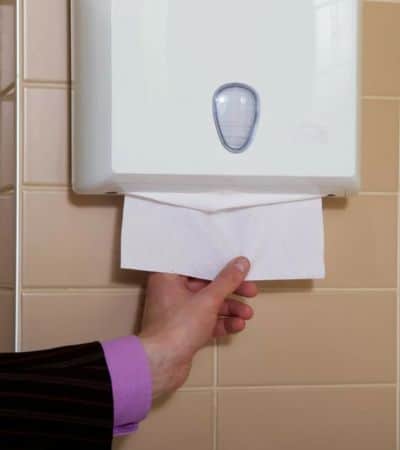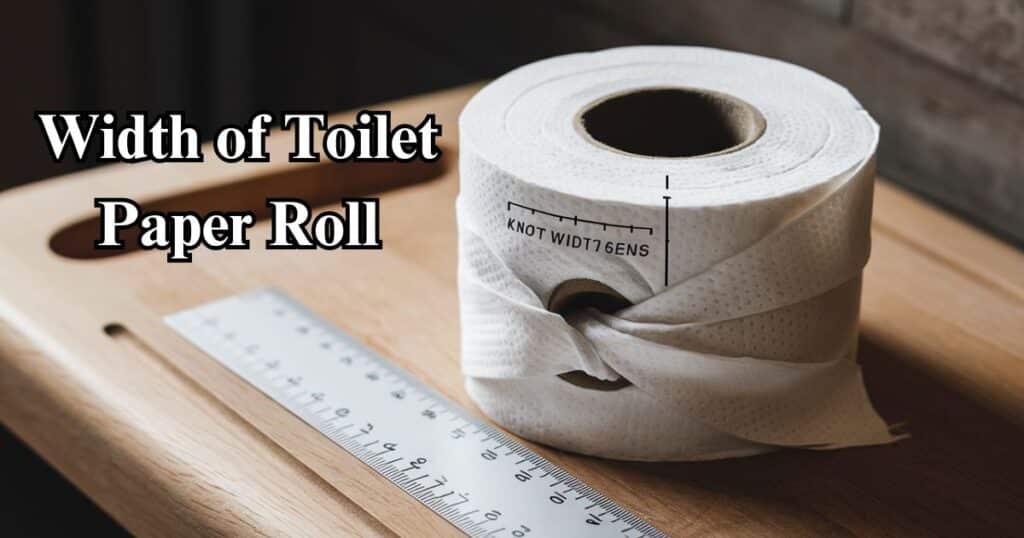Knot width, also known as sheet length or sheet width, refers to the measurement of the length and width of the tissue paper roll used to manufacture toilet paper.
It is calculated by taking the overall diameter of the toilet paper roll and subtracting the diameter of the inner cardboard core, then dividing that number by two.
For example, if a toilet paper roll has a 4.5 inch diameter and the cardboard core is 1.6 inches, the knot width would be (4.5 – 1.6)/2 = 1.45 inches.
This knot width measurement directly determines the size of the individual toilet paper sheets as well as how many sheets can fit on a single roll.
Understanding Knot Width in Toilet Paper Rolls
Knot width, also known as sheet length or sheet width, refers to the measurement of the length and width of the tissue paper roll, which is the raw material used to manufacture toilet paper. It is the distance between the inner cardboard core and the outer layer of paper on the roll.
The knot width is calculated by subtracting the diameter of the core (typically 1.6 inches or 4 cm) from the overall diameter of the tissue paper roll (ranging from 3.7 to 4.7 inches or 9.9 to 12 cm, depending on the quality and thickness of the paper), and then dividing the result by two.
For example, if the diameter of the tissue paper roll is 4.5 inches and the core diameter is 1.6 inches, the knot width would be:
Knot Width = (4.5 inches - 1.6 inches) / 2 = 1.45 inchesKnot width measurements are typically expressed in inches or centimeters and can vary based on the manufacturer and the specific type of toilet paper.
Why Knot Width Matters: Exploring Its Impact on Toilet Paper Quality

The knot width of toilet paper rolls has a direct influence on several key aspects of toilet paper performance and quality:
- Sheet Size: The sheet size, or the dimensions of individual toilet paper sheets, is directly proportional to the knot width. A larger knot width results in larger sheet sizes, providing more coverage area per wipe and potentially improving comfort and hygiene.
- Sheet Count: The number of sheets in a toilet paper roll is inversely proportional to the knot width. A smaller knot width allows for more sheets to be packed onto a single roll, increasing the roll’s longevity and potentially reducing overall costs and waste.
- Strength and Absorbency: While not directly related to knot width, the ply count (the number of layers in each sheet) affects the overall thickness, strength, and absorbency of the toilet paper. Knot width and ply count work together to determine the overall performance and user experience.
It’s important to note that adjusting the knot width can have both benefits and drawbacks. For instance, increasing the knot width can improve comfort and coverage but reduce the sheet count per roll, potentially increasing costs and waste. Conversely, decreasing the knot width can increase the sheet count but may compromise comfort and hygiene.
Deciphering Knot Width: A Key Factor in Toilet Paper Selection
When choosing toilet paper, knot width is a critical factor to consider alongside other features like ply count, material composition, and embossing patterns. Consumers should assess their personal preferences and needs to determine the ideal knot width for their household.
For example, larger knot widths (and consequently larger sheet sizes) may be preferred in households with children or seniors, where comfort and coverage are prioritized. On the other hand, smaller knot widths (and higher sheet counts) could be more suitable for compact storage or cost-conscious consumers.
Additionally, knot width can influence the overall cost and value of toilet paper. Larger knot widths generally translate to higher material costs, while smaller knot widths may offer better value for money in terms of sheet count per roll.
Knot Width 101: Essential Information for Consumers
As consumers become more informed about toilet paper specifications, understanding knot width labeling and terminology is crucial. Here are some essential points to keep in mind:
- Historical Context: Knot width standards have evolved over time, with manufacturers continually refining and optimizing measurements to improve performance and efficiency.
- Labeling Conventions: Toilet paper packaging often includes knot width information, either explicitly stated or implied through terms like “regular,” “double,” or “mega” roll sizes.
- Interpretation Tips: When evaluating knot width information on product labels, consider the core size, roll diameter, and sheet dimensions provided. These values can help you calculate and compare knot widths across different brands and products.
Being knowledgeable about knot width labeling and terminology empowers consumers to make informed purchasing decisions and find the toilet paper that best suits their needs.
Related Posts: The Dimensions of Toilet Tissue Rolls
Unraveling the Mystery: How Knot Width Affects Toilet Paper Performance
Beyond the basics of sheet size and count, knot width also influences several other aspects of toilet paper performance:
- Dissolvability and Septic Safety: Toilet papers with larger knot widths and larger sheet sizes may be more prone to clogging or causing issues in septic systems due to their increased surface area and slower dissolvability.
- Dispensing and Ease of Use: The knot width can affect how smoothly toilet paper dispenses from the roll and how easily it tears or separates along the perforations. Larger knot widths may create more resistance or friction during dispensing.
- Durability and Resistance to Tearing: The relationship between knot width and the overall strength and durability of toilet paper is complex. While larger knot widths may initially seem more prone to tearing or shredding, the interplay with ply count and material composition also plays a crucial role.
By understanding these performance factors, manufacturers can optimize knot width selections to strike the right balance between user experience, septic safety, and overall functionality.
Comparing Knot Widths: Finding the Right Toilet Paper for You

To help you navigate the world of knot widths and find the toilet paper that best suits your needs, here are some general guidelines and considerations:
- Compact Storage: For households with limited storage space or those prioritizing compact packaging, knot widths in the range of 1.2 to 1.4 inches may be ideal, as they allow for more sheets per roll.
- Households with Children or Seniors: Larger knot widths around 1.5 to 1.7 inches can provide larger sheet sizes and improved coverage, making them more suitable for households with young children or elderly individuals.
- Cost Considerations: If cost is a primary concern, toilet papers with smaller knot widths (around 1.2 to 1.4 inches) may offer better value in terms of sheet count per roll, potentially reducing overall costs over time.
It’s also helpful to compare knot widths across popular toilet paper brands. Here’s a quick overview:
BrandKnot Width (inches)Brand A1.3Brand B1.5Brand C1.4Brand D1.6
Remember, knot width is just one factor among many when selecting toilet paper. Consider your specific needs, preferences, and other important features like ply count and material composition to make the most informed choice.
From Manufacturing to Usage: The Journey of Knot Width in Toilet Paper Rolls
Knot width plays a crucial role throughout the toilet paper manufacturing process, from the initial production of tissue paper rolls to the final packaging and distribution:
- Manufacturing Process: During the tissue paper production stage, knot width is carefully controlled and adjusted to meet desired specifications. Manufacturers use specialized equipment and techniques to wind the paper onto the cardboard cores at precise diameters and tensions.
- Quality Control: Rigorous quality control measures are employed to ensure consistent knot width measurements across all toilet paper rolls produced. Any deviations or variations can impact downstream processes and product performance.
- Packaging and Transportation: Knot width considerations extend to the packaging and transportation of toilet paper rolls. The dimensions of the rolls and their respective knot widths influence the design of packaging materials and the optimization of shipping and distribution logistics.
By understanding the journey of knot width from manufacturing to usage, manufacturers can identify opportunities for process improvements, cost savings, and enhanced product quality.
The Science Behind Knot Width: Insights into Toilet Paper Engineering
- Balancing Trade-offs: Knot width selection often involves balancing trade-offs between various factors, such as cost, performance, and user experience. For example, a smaller knot width may reduce material costs but potentially compromise comfort or septic safety. Manufacturers employ advanced optimization techniques to find the ideal knot width that satisfies multiple constraints and objectives.
- Innovations and Research: The toilet paper industry continually invests in research and development to explore new materials, manufacturing processes, and technologies that can improve knot width control, consistency, and overall product quality. Ongoing innovations in areas like embossing, perforating, and winding techniques can impact knot width considerations.
By leveraging scientific principles and engineering methodologies, manufacturers can make informed decisions about knot width selections, ensuring optimal performance, efficiency, and user satisfaction.
Optimizing Comfort and Efficiency: The Role of Knot Width in Toilet Paper Design
Knot width is a critical consideration in the overall toilet paper design process, as it interacts with and influences various other features and characteristics:
- Interplay with Other Features: Knot width must be carefully balanced with factors like ply count, embossing patterns, and material composition to achieve the desired comfort, strength, and absorbency levels. Manufacturers use sophisticated design tools and simulations to analyze the interplay between these elements.
- User Experience Optimization: By optimizing knot width in conjunction with other design elements, manufacturers can enhance the overall user experience. For example, larger knot widths combined with embossed textures can improve softness and comfort, while smaller knot widths with high ply counts can provide exceptional strength and durability.
- Efficiency and Sustainability: Knot width optimization can also contribute to improved efficiency and sustainability in toilet paper production. By reducing material waste, optimizing roll densities, and minimizing transportation costs, manufacturers can achieve significant cost savings and reduce their environmental impact.
Through a holistic design approach that considers knot width as a key variable, toilet paper manufacturers can create products that strike the perfect balance between comfort, performance, and efficiency.
Choosing Wisely: Factors to Consider When Assessing Knot Width in Toilet Paper
When evaluating knot width and selecting the most suitable toilet paper for your needs, it’s essential to consider a range of factors beyond just the knot width measurement itself. Here’s a comprehensive checklist to guide your decision-making process:
- Personal Preferences and Needs:
- Comfort and coverage requirements
- Household size and usage patterns
- Storage space constraints
- Cost considerations
- Toilet Paper Specifications:
- Ply count
- Material composition (e.g., virgin fiber, recycled content)
- Embossing patterns and textures
- Perforation strength and ease of tearing
- Performance Factors:
- Septic safety and dissolvability
- Dispensing smoothness and ease of use
- Durability and resistance to tearing or shredding
- Environmental Impact:
- Sustainability practices of the manufacturer
- Packaging and transportation considerations
- Recyclability or biodegradability of the product
- Brand Reputation and Customer Reviews:
- Quality and consistency ratings
- User experiences with different knot widths
- Customer service and support
By carefully evaluating these factors alongside knot width, you can make an informed decision that aligns with your priorities, preferences, and overall needs.
Final Words
To sum it up, knot width is a seemingly minor yet crucial specification of toilet paper rolls that greatly influences product quality, user experience, and manufacturing processes. Understanding the significance of knot width empowers consumers to make informed choices based on their preferences and needs.
For manufacturers, optimizing knot width involves careful consideration of factors such as cost, quality, and sustainability. By recognizing the importance of knot width and its impact, both consumers and manufacturers can contribute to a more efficient, sustainable, and enjoyable toilet paper experience for all.







